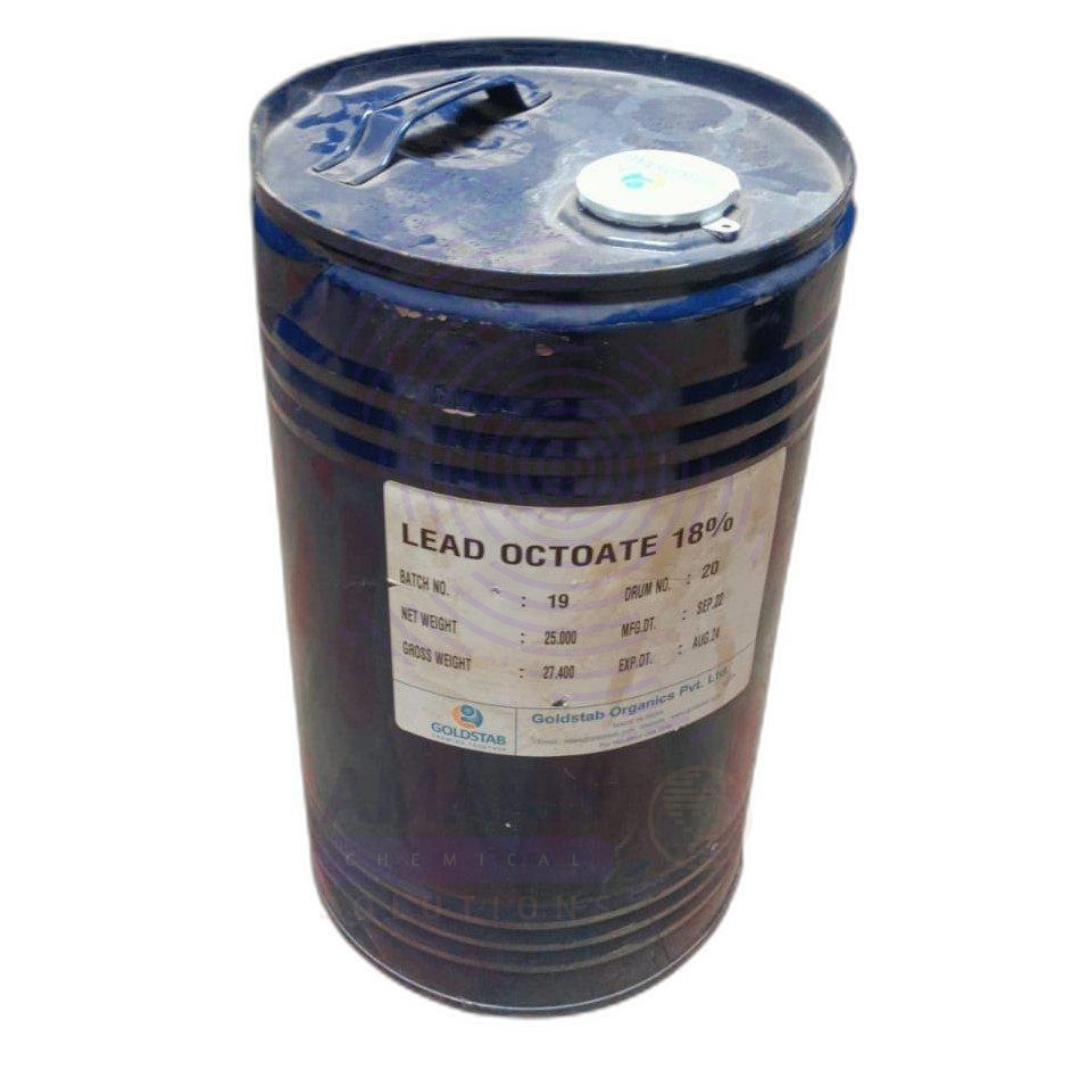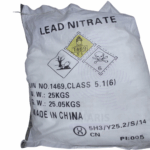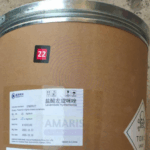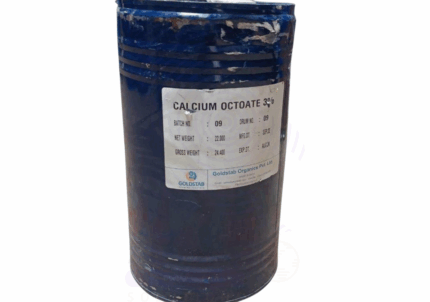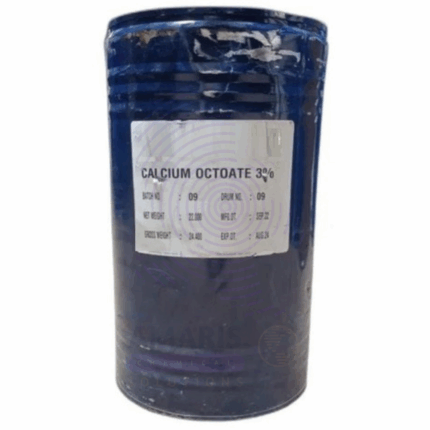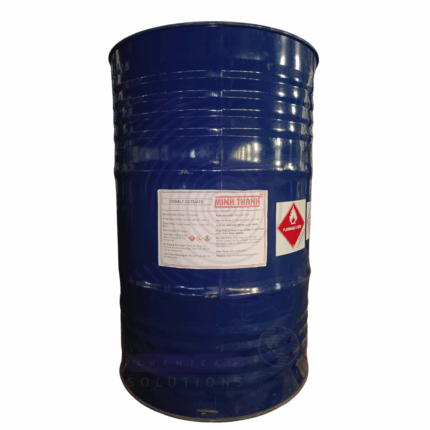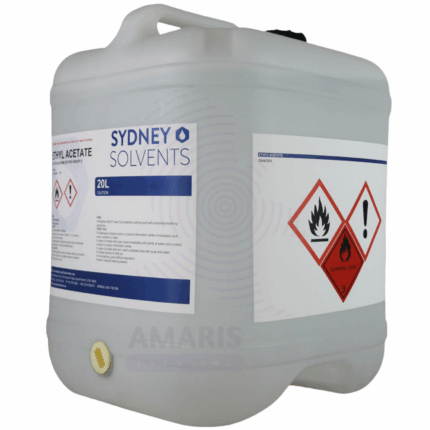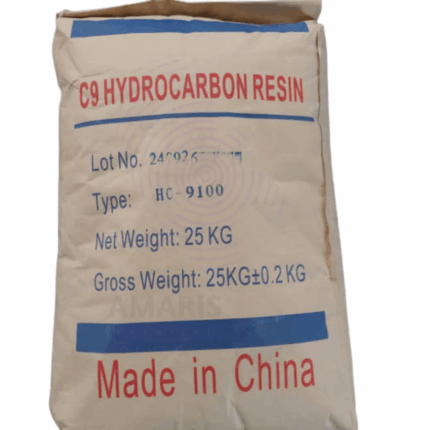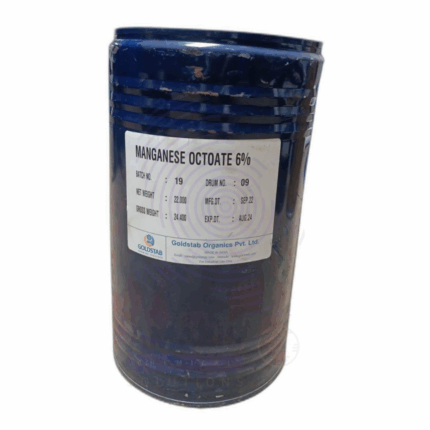Lead Octoate
Whatsapp Order
Lead Octoate is a viscous liquid solution containing 30% lead octoate, a metal soap derived from lead and 2-ethylhexanoic acid (also known as octanoic acid). It is primarily used as a drying agent (drier) in paints, varnishes, and coatings to accelerate the curing process by promoting oxidation and polymerization of drying oils. This product is widely employed in industrial coatings to improve drying times, hardness, and durability of surface films. Packaged typically in 250kg drums, Lead Octoate 30% is handled with care due to the toxic nature of lead compounds.
Category: Driers
Tags: Industrial Finishes, Lead Drier, Lead Octoate 30%, Paints & Coatings
Description
Table of Contents
Toggle
Lead Octoate
Primary Uses
- Paints and Coatings Industry
- Functions as a primary drier in alkyd, oil-based, and other air-drying paints and varnishes to accelerate surface drying.
- Enhances hardness, gloss, and adhesion of coatings by promoting oxidative cross-linking of oils.
- Used in industrial, automotive, and marine coatings where fast drying and durability are essential.
- Ink Manufacturing
- Applied as a drying agent in printing inks, especially those based on oils or alkyd resins.
- Rubber and Plastics Industry
- Used as a catalyst for curing and processing rubber compounds and some plastic formulations.
Secondary Uses
- Leather Finishing
- Occasionally used as a catalyst in leather finishing formulations to improve drying and film formation.
- Adhesives and Sealants
- Acts as a curing accelerator in certain adhesive and sealant products involving oil-based components.
- Chemical Intermediates
- Employed in small quantities in chemical syntheses involving metal soaps and organometallic catalysts.
KEY PRODUCT FEATURES
1. Basic Identification Attributes
- Chemical Name (IUPAC): Lead(II) 2-ethylhexanoate (solution in oil or solvent)
- Common/Trade Name: Lead Octoate 30%
- CAS Number: 301-04-2 (Lead 2-ethylhexanoate)
- HS Code: 3824.90.00
- Synonyms: Lead 2-ethylhexanoate; Lead octanoate; Lead metal soap; Lead drying agent
2. Physical & Chemical Properties
- Physical State: Viscous liquid
- Color & Odor: Pale yellow to amber; characteristic mild odor
- Solubility: Insoluble in water; soluble in oils and organic solvents
- Density: Approximately 1.1 – 1.2 g/cm³ (varies by formulation)
- Flash Point: Depends on solvent content, typically above 100 °C (may vary)
3. Safety & Hazard Attributes
- GHS Classification: Toxic (Category 1); Skin sensitizer; Hazardous to aquatic environment
- Toxicity: Highly toxic due to lead content; harmful if inhaled, ingested, or absorbed through skin
- Exposure Limits: OSHA PEL for lead compounds: 50 µg/m³ (airborne lead)
4. Storage & Handling Attributes
- Storage Conditions: Store in tightly sealed containers in a cool, dry, well-ventilated area away from heat, sparks, and open flames
- Container Type: 250kg steel or plastic drums designed for hazardous liquids
- Shelf Life: Typically 12-24 months if stored properly
- Handling Precautions: Use full PPE including gloves, goggles, and respiratory protection; avoid skin contact and inhalation of vapors
5. Regulatory & Compliance Attributes
- Subject to strict regulations for lead compounds under OSHA, REACH, and EPA
- Labeling required for toxic, hazardous, and environmental risks
- Usage restricted or phased out in some regions due to lead toxicity concerns
6. Environmental & Health Impact
- Biodegradability: Not biodegradable
- Ecotoxicity: Highly toxic to aquatic life with long-lasting effects
- Bioaccumulation: Lead compounds bioaccumulate in organisms, causing environmental hazards
- Carcinogenicity/Mutagenicity: Lead is classified as a probable human carcinogen
SAFETY HANDLING PRECAUTIONS
Safety Handling Precautions
- PPE Required: Chemical-resistant gloves, safety goggles, protective clothing, and respirators in poorly ventilated areas
- Handling Guidelines: Use in well-ventilated spaces; avoid inhalation, ingestion, and skin contact; follow strict hygiene practices
- Storage Measures: Store away from incompatible substances like acids, oxidizers, and moisture
First Aid Measures
- Inhalation: Move to fresh air immediately; seek medical attention if symptoms persist
- Skin Contact: Wash affected area with soap and water thoroughly; seek medical advice if irritation occurs
- Eye Contact: Rinse eyes with plenty of water for 15 minutes; get medical help
- Ingestion: Do not induce vomiting; rinse mouth and seek urgent medical attention
Firefighting Measures
- Fire Hazards: Not highly flammable but may ignite under certain conditions due to solvent content
- Extinguishing Media: Use foam, dry chemical, or carbon dioxide extinguishers
- Special Precautions: Firefighters should wear full protective gear and self-contained breathing apparatus
- Hazardous Combustion Products: May produce lead oxides and toxic fumes upon combustion
Related products
Calcium Drier
Calcium Drier is a metal-based drying agent primarily composed of calcium salts of fatty acids (commonly calcium octoate or calcium linoleate), widely used as a siccative in paints, varnishes, inks, and coatings. It functions as a catalyst to accelerate the oxidative cross-linking and polymerization of drying oils, leading to faster drying times and improved film hardness and durability. Calcium Driers are valued for their good compatibility with other driers, low toxicity, and efficient catalytic activity at low concentrations. They are commonly used alone or in combination with other metal driers such as cobalt or manganese driers for optimized drying performance.
Calcium Octoate
Calcium Octoate 10% is an aqueous solution containing 10% calcium octoate, a calcium salt of 2-ethylhexanoic acid (octanoic acid). It is a white to pale yellow liquid, soluble in water, known primarily as a metal carboxylate used as a drying agent and corrosion inhibitor. It functions as a calcium-based drier in coatings, paints, varnishes, and printing inks to accelerate the curing process by catalyzing the oxidation and polymerization of drying oils. Due to its stability and efficacy at low concentrations, it is widely preferred as a non-toxic alternative to traditional lead or cobalt-based driers.
Cobalt Octoate
Cobalt Octoate is a liquid metal drying agent solution consisting of 10% cobalt octoate dissolved in an organic solvent carrier (typically mineral spirits or similar hydrocarbon solvent). It functions as a highly efficient catalyst to accelerate the oxidative curing and drying of alkyd resins, oils, and varnishes in coatings and paints. By promoting cross-linking and polymerization of unsaturated fatty acids in drying oils upon exposure to oxygen, it significantly reduces drying time and enhances film hardness, gloss, and durability. Cobalt Octoate 10% is widely used in industrial and decorative coatings, inks, and adhesives, valued for its strong catalytic activity even at low concentrations.
Ethyl Acetate
Ethyl Acetate is a clear, colorless, volatile organic solvent with a characteristic sweet, fruity odor reminiscent of pear drops. It is an ester formed by the condensation of ethanol and acetic acid. Known for its excellent solvency, low toxicity, and rapid evaporation rate, Ethyl Acetate is widely used as a solvent in coatings, adhesives, inks, pharmaceuticals, and chemical synthesis. It is miscible with most organic solvents and partially soluble in water. Ethyl Acetate offers high volatility, making it ideal for quick-drying formulations.
Hydrocarbon Resins
Hydrocarbon Resins C5 And C9 Petroleum Resins are synthetic petroleum-derived resins produced through the polymerization of C5 (pentene) and C9 (nonene) fraction monomers. These resins appear as pale yellow to amber solid materials, usually in pellet or flake form, characterized by tackifying and adhesive properties. C5 resins are derived from aliphatic hydrocarbons, while C9 resins originate from aromatic hydrocarbons. Often blended, these resins provide a balance of hardness, tackiness, and compatibility with various polymers. Widely used as tackifiers, binders, and modifiers, C5 & C9 hydrocarbon resins enhance performance in adhesives, coatings, rubber compounding, and more.
Manganese Octate Drier
Manganese Octate Drier is a metal-organic compound commonly used as an oxidative catalyst in alkyd and oil-based coating systems. It is a manganese salt of 2-ethylhexanoic acid (octanoic acid) dissolved in a compatible organic solvent, typically white spirit or hydrocarbon thinner. At a 10% metal concentration, this drier functions as a primary oxidative (surface) drier, accelerating the polymerization and hardening of unsaturated oils and alkyd resins upon exposure to air. It exhibits a dark brown to violet color, has low viscosity, and is highly effective in small doses.
Petroleum Resin C9 Hydrocarbon
Petroleum Resin C9 Hydrocarbon is a thermoplastic hydrocarbon resin derived from the C9 fraction of petroleum cracking. It is a tackifying resin with excellent compatibility with various polymers, especially in adhesives, paints, rubber, and coatings industries. Known for its good color stability, fast curing, and strong adhesion properties, C9 Petroleum Resin enhances product performance in many industrial applications.
Zicronium Octoate
Zicronium Octoate is a metal carboxylate solution comprising zirconium ions complexed with octoic acid at an 18% zirconium concentration. It serves as an effective crosslinking and curing agent in coatings, adhesives, and sealants, enhancing film hardness, chemical resistance, and durability. This zirconium-based additive is valued for its catalytic properties in accelerating the curing of various polymer systems, especially in automotive and industrial applications.


 Preservatives(food)
Preservatives(food) Flavor Enhancers
Flavor Enhancers Acidulants
Acidulants Sweeteners
Sweeteners Antioxidants
Antioxidants Colorants(food)
Colorants(food) Nutraceutical Ingredients (food)
Nutraceutical Ingredients (food) Nutrient Supplements
Nutrient Supplements Emulsifiers
Emulsifiers
 Collectors
Collectors Dust Suppressants
Dust Suppressants Explosives and Blasting Agents
Explosives and Blasting Agents Flocculants and Coagulants
Flocculants and Coagulants Frothers
Frothers Leaching Agents
Leaching Agents pH Modifiers
pH Modifiers Precious Metal Extraction Agents
Precious Metal Extraction Agents
 Antioxidants(plastic)
Antioxidants(plastic) Colorants (Pigments, Dyes)
Colorants (Pigments, Dyes) Fillers and Reinforcements
Fillers and Reinforcements Flame Retardants
Flame Retardants Monomers
Monomers Plasticizers
Plasticizers Polymerization Initiators
Polymerization Initiators Stabilizers (UV, Heat)
Stabilizers (UV, Heat)
 Antifoaming Agents
Antifoaming Agents Chelating Agents
Chelating Agents Coagulants and Flocculants
Coagulants and Flocculants Corrosion Inhibitors
Corrosion Inhibitors Disinfectants and Biocides
Disinfectants and Biocides Oxidizing Agents
Oxidizing Agents pH Adjusters
pH Adjusters Scale Inhibitors( water)
Scale Inhibitors( water)
 Antioxidants(cosmetic)
Antioxidants(cosmetic) Emollients
Emollients Fragrances and Essential Oils
Fragrances and Essential Oils Humectants
Humectants Preservatives
Preservatives Surfactants(cosmetic)
Surfactants(cosmetic) Thickeners
Thickeners UV Filters
UV Filters
 Fertilizers
Fertilizers Soil Conditioners
Soil Conditioners Plant Growth Regulators
Plant Growth Regulators Animal Feed Additives
Animal Feed Additives Biostimulants
Biostimulants Pesticides (Herbicides, Insecticides, Fungicides)
Pesticides (Herbicides, Insecticides, Fungicides)
 Active Pharmaceutical Ingredients (APIs)
Active Pharmaceutical Ingredients (APIs) Excipients
Excipients Solvents(pharmaceutical)
Solvents(pharmaceutical) Antibiotics
Antibiotics Antiseptics and Disinfectants
Antiseptics and Disinfectants Vaccine Adjuvants
Vaccine Adjuvants Nutraceutical Ingredients (pharmaceutical)
Nutraceutical Ingredients (pharmaceutical) Analgesics & Antipyretics
Analgesics & Antipyretics
 Analytical Reagents
Analytical Reagents Solvents(lab)
Solvents(lab) Chromatography Chemicals
Chromatography Chemicals Spectroscopy Reagents
Spectroscopy Reagents microbiology-and-cell-culture-reagents
microbiology-and-cell-culture-reagents Molecular Biology Reagents
Molecular Biology Reagents Biochemical Reagents
Biochemical Reagents Inorganic and Organic Standards
Inorganic and Organic Standards Laboratory Safety Chemicals
Laboratory Safety Chemicals Specialty Laboratory Chemicals(Special Laboratory Equipment)
Specialty Laboratory Chemicals(Special Laboratory Equipment)
 Demulsifiers
Demulsifiers Hydraulic Fracturing Fluids
Hydraulic Fracturing Fluids Scale Inhibitors(oil)
Scale Inhibitors(oil) Surfactants(oil)
Surfactants(oil) Drilling Fluids
Drilling Fluids
 Dyes and Pigments
Dyes and Pigments Bleaching Agents
Bleaching Agents Softening Agents
Softening Agents Finishing Agents
Finishing Agents Antistatic Agents
Antistatic Agents
 Admixtures
Admixtures Waterproofing Agents
Waterproofing Agents Sealants and Adhesives
Sealants and Adhesives Curing Compounds
Curing Compounds Concrete Repair Chemicals
Concrete Repair Chemicals Anti-Corrosion Coatings
Anti-Corrosion Coatings
 Surfactants(cleaning)
Surfactants(cleaning) Builders
Builders Enzymes
Enzymes Solvents (Cleaning)
Solvents (Cleaning) Fragrances
Fragrances
 Electronic Chemicals
Electronic Chemicals Catalysts
Catalysts Lubricants
Lubricants Photographic Chemicals
Photographic Chemicals Refrigerants
Refrigerants Automotive chemicals
Automotive chemicals Pyrotechnic Chemicals
Pyrotechnic Chemicals
 Biodegradable Surfactants
Biodegradable Surfactants Bio-based Solvents
Bio-based Solvents Renewable Polymers
Renewable Polymers Carbon Capture Chemicals
Carbon Capture Chemicals Wastewater Treatment Chemicals
Wastewater Treatment Chemicals
 Pigments
Pigments Solvents(paint)
Solvents(paint) Specialty Coatings
Specialty Coatings Binders/Resins
Binders/Resins Additives
Additives Driers
Driers Anti-Corrosion Agents
Anti-Corrosion Agents Functional Coatings
Functional Coatings Application-Specific Coatings
Application-Specific Coatings
 Fresh Herbs
Fresh Herbs Ground Spices
Ground Spices Whole Spices
Whole Spices Spice Blends
Spice Blends Dried Herbs
Dried Herbs
 Leavening Agents
Leavening Agents Dough Conditioners
Dough Conditioners Flour Treatments
Flour Treatments Fat Replacers
Fat Replacers Decoratives
Decoratives Preservatives(baking)
Preservatives(baking)
 Plasticizers & Softeners
Plasticizers & Softeners Reinforcing Agents
Reinforcing Agents Adhesion Promoters
Adhesion Promoters Vulcanizing Agents
Vulcanizing Agents Antidegradants
Antidegradants Blowing Agents
Blowing Agents Fillers & Extenders
Fillers & Extenders Accelerators & Retarders
Accelerators & Retarders